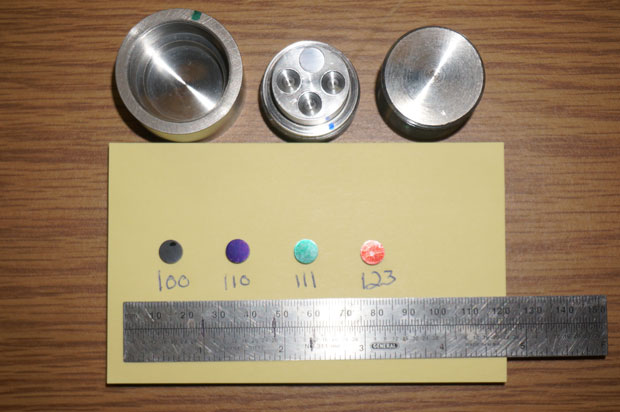Luke Hsiung (16-ERD-043)
Project Description
Understanding deformation mechanisms in materials with weapons-related applications is crucial to developing predictive models of the behavior of these materials. We will conduct three shock-impact experiments using Livermore's gas gun facility to drive body-centered cubic tantalum single-crystal samples (in a body-centered cubic material, one lattice point of the crystal's structure is at the center of a cube) under high pressures (>50 GPa) and high strain rates (105–106/s). We intend to explore deformation mechanisms of these metals that are shock loaded under extreme conditions. We will characterize the shock-recovered samples using high-resolution transmission electron microscopy to determine what causes the slip-twinning and slip-phase transitions and the relationship between dislocation structures (the crystallographic defects within crystal structures) and secondary deformation modes—that is, deformation twinning (the plastic deformation of a crystal under stress by gliding along crystal planes) and material phase transformation. In slip twinning, a section of the atoms in the area of crystal under stress rearrange themselves into a mirror image of the original crystal's structure, while in a slip-phase transition, planes of crystal slip past one another into a displaced pattern of deformation. These questions have growing urgency because multiscale material models have been developed that rely on knowledge of deformation mechanisms, and need both guidance and validation. Our effort will focus on body-centered cubic tantalum because of its relevance to multiscale model development.
The capability to determine deformation mechanisms will have an impact on the development of predictive constitutive materials models for weapons applications. With the increasing power of high-performance computers and multiscale modeling techniques, it is becoming possible to develop constitutive models with parameters derived entirely from first principles. Our approach emphasizes the extraordinary detail provided by high-resolution transmission electron microscopy imaging of deformed materials, especially its unique ability to measure dislocation density and twin characteristics including size, morphology, and spatial distribution. A successful outcome of our project will demonstrate that there is an intimate relationship between dislocation structures and secondary deformation modes in shock-loaded tantalum single crystals. This may enable further research opportunities by providing data and information needed to identify the relevant mechanisms to include in multiscale modeling. Once the technique has been demonstrated for tantalum, we expect the approach can be applied to materials of interest to other research activities—there is a strong programmatic need for constitutive model development at Livermore. Our approach will build on two recognized strengths of Livermore: material dynamics (gas gun experiments) and material characterization (high-resolution transmission electron microscopy).
Mission Relevance
Material deformation models are typically formulated based on a working hypothesis and dominant mechanisms, guided by years of experience, but at low rates and low pressures. Experiments that directly determine deformation mechanisms in materials under high stress loads can have an impact on extending the Laboratory's core competencies in high-performance computing (through improved material behavior modeling) and high-energy-density science (through high-stress experiments), as well as advancing its strategic focus in stockpile stewardship science.
FY16 Accomplishments and Results
Since the project's start in early April, we have completed procurement, machining, and preparation of single-crystal tantalum samples with four different orientations of [001], [011], [111], and [123], for the planned shock-recovery experiments (see figure). In addition, because of scheduling conflicts at Livermore, we initiated a plan to perform shock experiments using the gas gun facility at Washington State University in Spokane.






